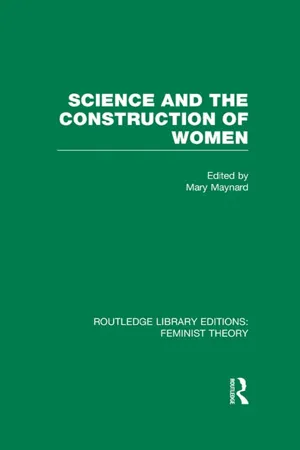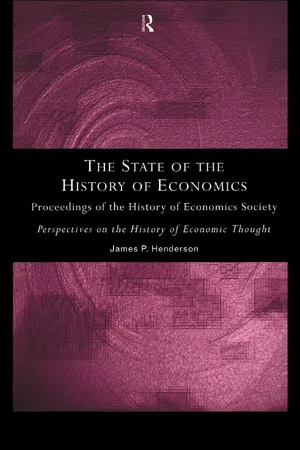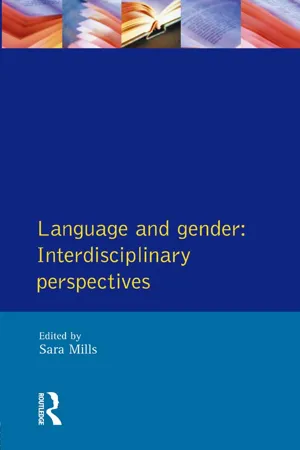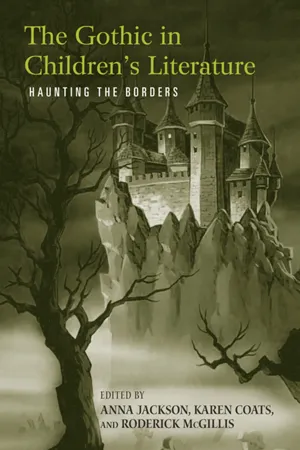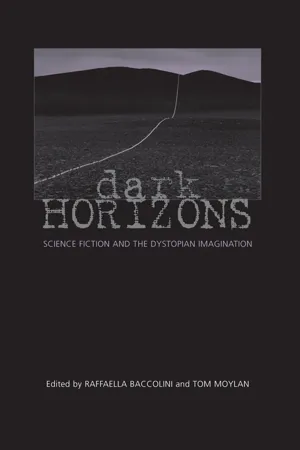Literature
Cyberpunk Literature
Cyberpunk literature is a subgenre of science fiction that emerged in the 1980s, characterized by its focus on high-tech, low-life scenarios, often set in dystopian futures. It typically features themes of advanced technology, artificial intelligence, and the impact of corporate control on society. Cyberpunk works often explore the blurred boundaries between humans and machines, and the consequences of rapid technological advancement.
Written by Perlego with AI-assistance
Related key terms
Related key terms
1 of 4
Related key terms
1 of 3
8 Key excerpts on "Cyberpunk Literature"
- Mary Maynard(Author)
- 2012(Publication Date)
- Routledge(Publisher)
The Furies (1994, 1995). Inevitably, this has helped to perpetuate the assumption that science and technology are irrevocably linked to masculinity, a link that the feminist critique of science has been concerned to deconstruct, as has feminist science fiction in its reaction against hard science fiction. Cyberpunk itself seems to be situated within hard SF because of its fascination with the new technologies of information, and thus, as Nicola Nixon argues, it could be said to have ‘represented a concerted return to the (originary) purity of hard SF, apparently purged of the influence of other-worldly fantasy, and embracing technology with new fervor’ (1992: 220). However, despite cyberpunk's apparently uncritical identification with science, it has nevertheless provided alternative ways of envisioning the relationships between human and machine, organic and non-organic and, ultimately, between self and other. The fictions of cyberpunk enact what Thomas Foster describes as ‘a literalizing of the effects of inhabiting a postmodern communications environment’ (1993: 3), and as such they have helped to generate a creative space within which identity can become ambivalent and thus problematic.Although cyberpunk has become an umbrella term characterizing a wide range of cultural productions, including music, performance art, film and video, it was originally used to describe William Gibson's science fiction novel Neuromancer (1986), and the cyberpunks were a small group of SF writers whose work was drawn together into an anthology of short stories edited by Bruce Sterling, Mirrorshades (1988). With the exception of Pat Cadigan, all the writers in the anthology are white and male, and the main connection between their work is the fact that it draws on the counter-cultural ethos of punk and rock and roll, combined with the flirtatious world of hacking. Cyberpunk is both a celebration and a critique of the destabilizing impact of new technology and transitional corporate capitalism; it ironically collapses the distinction between the present and the future by constructing credible, technologically enhanced near futures. These postmodern near futures are unstable, incoherent and saturated with the problems and possibilities of information technology. They disrupt the familiar linear relationship between the present and the future, and in so doing they blur the distinction between utopia and dystopia. The unstable postmodern environment of cyberpunk is precisely the kind of environment that opens up real possibilities for rethinking representations of gender, and social and sexual relations generally. The initial excitement generated by cyberpunk has, however, declined, and its counter-cultural pretensions have not been sustained. It has become increasingly clear that the promise that cyberpunk held for new representations of gender and new social and sexual configurations would not be fully explored without the intervention of women, either as performers, directors or writers. Not only was there an almost complete absence of women writers from the first flush of cyberpunk, but cyberpunk itself has never acknowledged the clear debt that it owed to feminist science fiction in terms of both narrative construction and gender representation. The lean, mean anti-heroes of cyberpunk are reminiscent of the familiar hard-boiled urban cowboys of other popular narratives, except that instead of walking down the mean streets of Tokyo, New York or Los Angeles, these computer cowboys jack into cyberspace by means of direct neural input. Cyberpunk transforms the archetypal figure of the adolescent white, male hacker into a street-wise operator who cruises the information highways as disembodied consciousness, freed from the troublesome body, or the ‘meat’ as Gibson's characters contemptuously refer to it. The body was a source of continuing anguish for these cyberpunk cowboys, and in Gibson's cyberpunk novels they leave it for the new frontiers of cyberspace as fast and as often as they can; some of them, like Bobby in Mona Lisa Overdrive- eBook - ePub
The State of the History of Economics
Proceedings of the History of Economics Society
- James P. Henderson(Author)
- 1997(Publication Date)
- Routledge(Publisher)
In the next section we explain what this literature contains, then we suggest what it signifies for the history of economics, and finally we ruminate about its impact on contemporary society.This paper explores a body of literature from the 1980s referred to as “cyberpunk” that both draws heavily on modern economic ideas and deals with them in a way that is reminiscent of but distinctly different from the earlier humanistic commentary. This literature provides a dystopian vision of the future of a liberal free-market society to contrast with Rand’s utopias on the same theme, and to complement Orwell’s socialist dystopia.A NEW BRAND OF SCIENCE FICTION
Who are the cyberpunk writers? The originals—Rudy Rucker, Lewis Shiner, John Shirley, and Bruce Sterling—were a small coterie of contributors to Cheap Truth, a freely distributed, uncopyrighted science-fiction magazine that ran from the mid-1970s to the early 1980s. In 1984, William Gibson wrote the canonical work Neuromancer, which has become the manifesto of the movement. By the late 1980s, Gibson, Sterling, Rucker, Shiner, and Shirley, along with Walter Jon Williams and Pat Cadigan, had become the cyberpunk core. Gibson’s novels and short stories still best illustrate the genre.2Cyberpunk is a science fiction category with certain well-defined characteristics, the most prominent of which is commitment to an exploration of and inquiry into the social consequences of information technologies.3 Bruce Sterling explains in his introduction to the 1986 cyberpunk anthology Mirrorshades that cyberpunk authors are the first generation of science fiction writers to grow up in a science fictional world. Their concept of the future relies much more heavily on developing a projection from the present and on the world already around them than imaginative speculations of their “hard SF” predecessors (Sterling 1986, xi). Others, too, view cyberpunk as a reflection of the present. William Gibson has said in regard to his work Neuromancer, - eBook - ePub
Language and Gender
Interdisciplinary Perspectives
- Sara Mills(Author)
- 2014(Publication Date)
- Routledge(Publisher)
3 and many of the narratives that have been produced have been strongly influenced by feminism, as is evidenced by the way in which gender and identity have been placed at the centre of such narratives. In this chapter I shall be discussing some key writing strategies used by feminist writers of science fiction to subvert the generic stability of science fiction, thereby creating an environment of uncertainty within which conventional constructions of sexual difference can be questioned. I am primarily concerned with the use of narrative structures and codes drawn from other genres in which the feminine is not marginalised, such as romance fiction, and with the rewriting of the dominant metaphors of science fiction to create a conceptual and linguistic space within which the feminine can be coded as hegemonic. The metaphor of the cyborg, and its positioning in relating to cyberpunk, provides the focus for my argument that these strategies have been profoundly disruptive for the genre as a whole because, in challenging the dominance of the masculine in discourses about technology, they challenge the constraints of both genre and gender.Although the term ‘cyberpunk’ is one that is now used to describe cultural productions across a range of media, particularly film, video and performance, it first emerged in the 1980s as a sub-genre of science fiction. Cyberpunk constitutes a major intervention into the genre, and the writer whose name remains most clearly identified with it is William Gibson, although other writers such as Bruce Sterling, Lewis Shiner, Rudy Rucker and John Shirley were equally involved in promoting the idea that cyberpunk was a ‘movement’. Cyberpunk writing combines the language of information technology with the spatial and temporal dislocation that is characteristic of science fiction. The innovative syntax of cyberpunk draws on the rhetoric of postindustrial technology to present fictional landscapes that are ironic and playful, both in their simulation of surface reality and in their apparent effacement of the boundaries between inner and outer worlds. A notable feature of cyberpunk writing is its speed and dazzle, and in his introduction to the cyberpunk anthology Mirrorshades - eBook - ePub
Online Communication
Linking Technology, Identity, & Culture
- Andrew F. Wood, Matthew J. Smith(Authors)
- 2004(Publication Date)
- Routledge(Publisher)
Some, like H. G. Wells, proposed optimistic accounts of the potential for technology to resolve human problems and eliminate human weaknesses. However, many science fiction novelists offer a critique of that thesis. In the 19th century, Mary Shelley’s Frankenstein warned of the risks that follow our use of technology to attain godlike powers. Ultimately, she demonstrates, we create monstrosities. Nathaniel Hawthorne’s “Celestial Railroad” demonstrates how the use of technology, in this case a train on its way to heaven, provides us only illusory power and ultimately jeopardizes our very souls. Early in the 20th century, even our illusory powers over the machine began to be stripped away in literature such as E. M. Forster’s “The Machine Stops,” Karel Capek’s R.U.R. (Rossum’s Universal Robots), and Fredric Brown’s “The Answer.” A group of authors who launched a movement called cyberpunk have been quite successful in shaping our public concepts of technology and culture over the past two decades (Balsamo, 1995). Cyberpunk refers to a literary movement that took hold among many science fiction writers in the 1980s–its primary theme is the blurring distinction between humans and machines. As discussed later, some critics hold that cyberpunk no longer offers a coherent philosophy or critique in contemporary times. However, the question asked by cyberpunk authors remains critical in our day: What happens when our society gets all the things promised by pulp comics and Flash Gordon serials and science fiction novels? Answering this question, cyberpunk authors took a somewhat dim view of the future, given that the present—yesterday’s tomorrow—appears to have become a dehumanizing and dangerous time. They no doubt recalled the ringing promises of earlier visionaries who imagined 10-lane superhighways and nuclear-powered cities - eBook - ePub
- Sallie Westwood, John M Williams(Authors)
- 2018(Publication Date)
- Routledge(Publisher)
In a paper which is stimulating, polemical but very discourteous he argues that: cyberpunk science fiction can be read as a sort of social theory, while Baudrillard’s futuristic postmodern social theory can be read in turn as science fiction. This optic also suggests a deconstruction of sharp oppositions between literature and social theory, showing that much social theory contains a narrative and vision of the present and future, and that certain types of literature provide cogent mappings of the contemporary environment and, in the case of cyberpunk, of future trends. (Kellner 1995: 299) And continues: at the very moment when Baudrillard dropped the theoretical ball, losing his initiative, Gibson and cyberpunk picked it up, beginning their explorations of the new future world which Baudrillard had been exploring. (ibid.: 327) Gareth Branwyn writing in Mondo 2000 provides a useful description of cyberpunk as both a literary perspective and worldview: The future has imploded onto the present. There was no nuclear Armageddon. There’s too much real estate to lose. The new battlefield is people’s minds. ... The megacorps are the new governments. ... The U.S. is a big bully with lackluster economic power.... The world is splintering into a trillion subcultures and designer cults with their own language, codes and lifestyles. ... Computer-generated info-domains are the next frontiers. ... There is better living through chemistry.... Small groups or individual ‘console cowboys’ can wield tremendous power over governments, corporations etcThe coalescence of a computer ‘culture’ is expressed in self-aware computer music, art, virtual communities, and a hacker/street tech subculture... the computer nerd image is passe, and people are not ashamed anymore about the role the computer has in this subculture. The computer is a cool tool, a friend, important human augmentation. ... We’re becoming cyborgs - eBook - ePub
The Gothic in Children's Literature
Haunting the Borders
- Anna Jackson, Roderick McGillis, Karen Coats, Anna Jackson, Roderick McGillis, Karen Coats(Authors)
- 2013(Publication Date)
- Routledge(Publisher)
2 Cyberfiction and the Gothic Novel Nadia CrandallOn first consideration, cyberfiction and the Gothic novel appear to have little in common. The Gothic novel, generally agreed to have originated with The Castle of Otranto (1764), reached its late apogee in the closing decades of the nineteenth century with R. L. Stevenson’s Strange Case of Dr. Jekyll and Mr. Hyde (1886) and Bram Stoker’s Dracula ( 1 897). By contrast, cyberfiction found its earliest expression a century later in the cyberpunk stories of Philip K. Dick and his successors. Cyberfiction for children, moreover, is so recent a form that it is only just emerging as a coherent genre.The plots of cyberpunk, and its related genre steampunk, are often set not simply in the future, but in an alternative world where technological advances have followed an unexpected trajectory. In cyberpunk, the technologies are generally cybernetic in character, whereas steampunk variants tend to employ the technologies of the time in which they are set. Often these are quasi-Victorian settings, featuring steam and clockwork technologies used in the service of a dystopian narrative. Indeed, most cyberpunk and steampunk fiction concerns itself with the interface between humans and their machines, their “punk” character manifesting itself in the social breakdowns caused by the alienation its writers imagine are inherent in that interface.Cyberfiction texts also operate at the intersection of humans and machines, though they sometimes lack the dystopian agenda. In cyberfiction, the protagonists engage with virtual reality through computer games, the Internet, or other forms of interactive cyberspace, as well as with their real-world environments. In part because of the genre’s imaginative origins in Victorian fictions such as Mary Shelley’s Frankenstein - eBook - ePub
- Graham Murphy, Lars Schmeink, Graham Murphy, Lars Schmeink(Authors)
- 2017(Publication Date)
- Routledge(Publisher)
have suggested its politics are often more style than substance. There have thus always been hints in the cyberpunk tradition that—despite posturing about its outsider status and countercultural credentials—the subgenre speaks to and from a position of privilege. 1 While its heroes may not have been the industrialists at the center of the emerging information economy, they were those whose skills would continue to ensure their place in the changing global economy, even as the setting of cyberpunk fiction anticipated a predatory capitalist system in which all labor was precarious. While claims regarding the end of cyberpunk emerged almost as soon as the ink dried on the first printing of William Gibson’s Neuromancer (1984), the continued circulation of the term suggests that a more accurate assessment can be found in Thomas Foster’s claim that “cyberpunk didn’t so much die as experience a sea change into a more generalized cultural formation” (xiv). Foster positions cyberpunk within a longer history of posthumanist discourses within and beyond science fiction (sf) that conceptualize evolution beyond the current state of the human body and think about the possibilities for human survival beyond ecological collapse. Within this context it becomes easy to understand “how conservative political agendas can survive, even thrive, in technocultural contexts” (xiii), Foster argues as he explores how cyberpunk discourse fueled transhumanist fantasies of technological transcendence of both human embodiment and Earth’s ecosystems - eBook - ePub
Dark Horizons
Science Fiction and the Dystopian Imagination
- Tom Moylan, Raffaella Baccolini, Tom Moylan, Raffaella Baccolini(Authors)
- 2013(Publication Date)
- Routledge(Publisher)
CHAPTER 4 Cyberpunk and Dystopia: Pat Cadigan's Networks David Seed DOI: 10.4324/9781315810775-5 I In his discussion of utopian subgenres, Lyman Tower Sargent describes dystopia as a “non-existent society described in considerable detail and normally located in time and space that the author intended a contemporaneous reader to view as considerably worse than the society in which that reader lived” (9). The more the dystopian text includes a dimension of debate, by characters and within the narrative structure itself, about the values and directions of its future society, the more justified we would be in reading the narrative as a critical dystopia. The regimes of classical dystopias like George Orwell's Nineteen Eighty-Four and Ray Bradbury's Fahrenheit 451 are rationalized by leading institutional figures—O'Brien and Beatty—whose explanations challenge the protagonist's (and, by implication, the reader's) capacity to identify the faults of those regimes. The protagonist's defeat in argument can lead to physical submission, as happens in Orwell, or to the physical destruction of the raisonneur figure followed by a symbolic relocation of the self outside the confines of the regime, as in Bradbury. Although such extreme consequences do not occur in Pat Cadigan's science fiction, debate over the nature of her near-future societies is integral to her works. When asked in an interview whether she was utopian or dystopian, Cadigan replied: “I don't think adhering to either extreme is realistic. There is a middle-ground and that's where I see myself: on the cautionary but plausible line of thinking. … Human beings are neither utopian nor dystopian so that's what I choose to reflect in my books” (“Pat Cadigan: She's Nobody's Fool” on line). Cadigan's sentiments have been echoed by William Gibson who has stated similarly: “I don't think I'm dystopian at all. No more than I'm utopian. The dichotomy is hopelessly old-fashioned really
Index pages curate the most relevant extracts from our library of academic textbooks. They’ve been created using an in-house natural language model (NLM), each adding context and meaning to key research topics.
Explore more topic indexes
Explore more topic indexes
1 of 6
Explore more topic indexes
1 of 4
